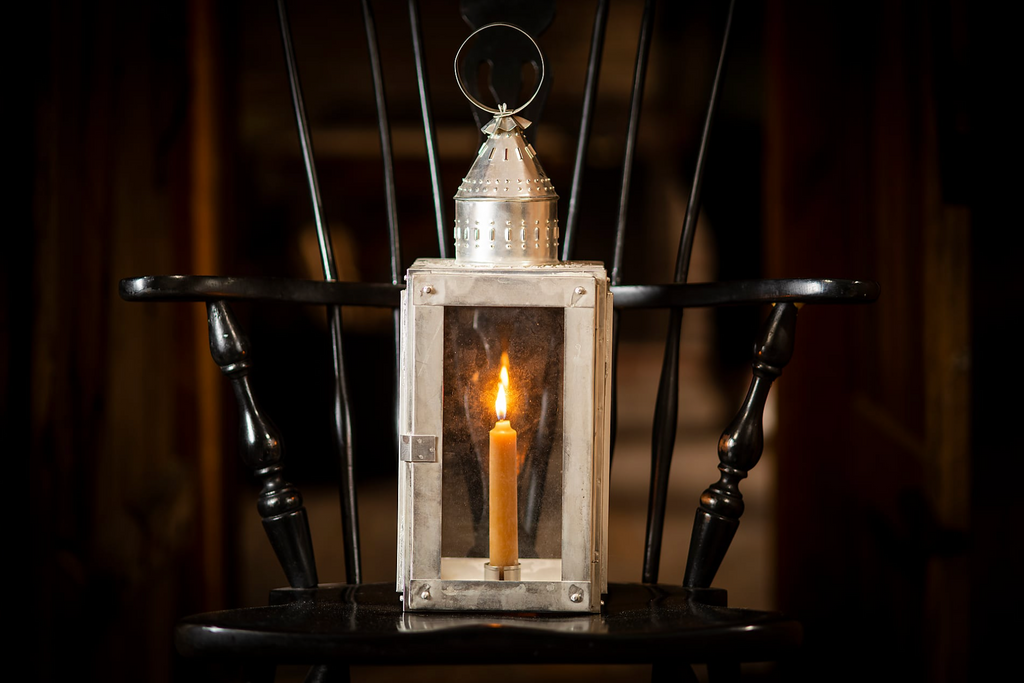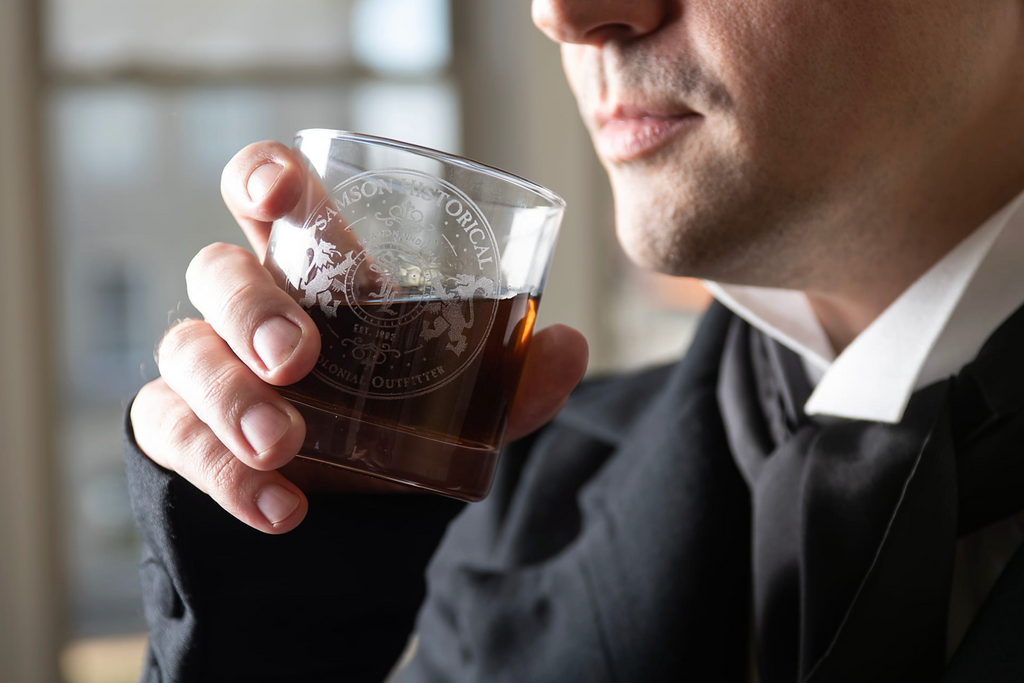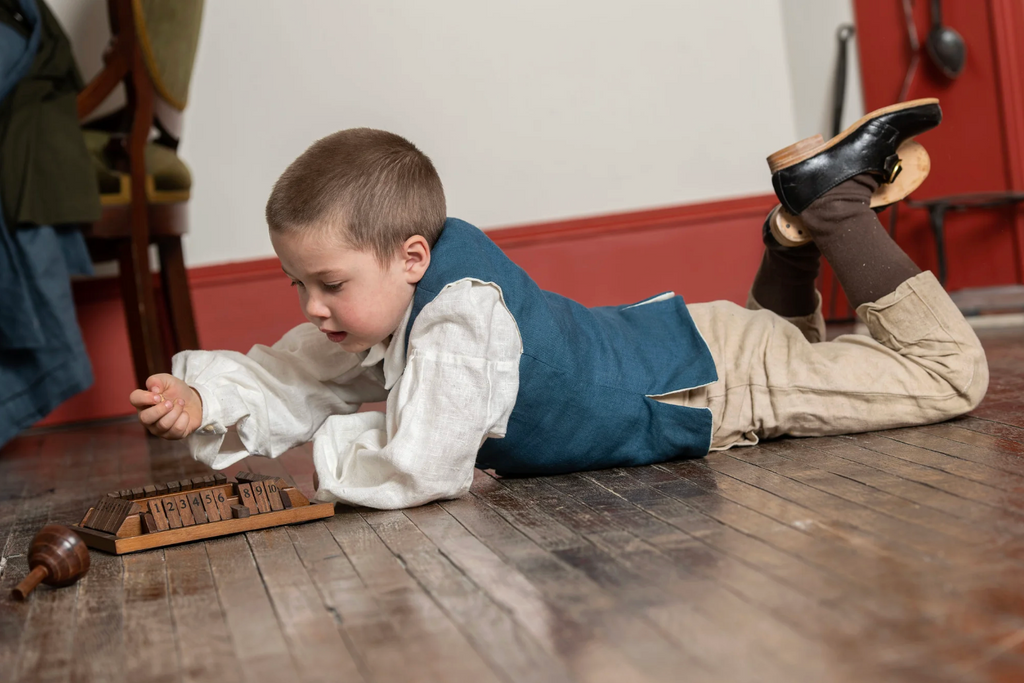Men’s Clothing
Women’s Clothing
Children's Clothing
The Caged Bird Sings
by Hannah Reece 14 min read

by Mayanka Dingra
The archaic yet elegant birdcages of antiquity often seem a frivolous accessory item. However, they and their inhabitants took on a symbolic role in the 17th and 18th century that transcended geographic bounds and class lines. As settlers expanded the reach of Europe’s empires into North America, they brought with them tokens of life back home. In the absence of modern modes of auditory stimulation, songbirds adorned the windowsills and cages of early American homes, filling the air with familiar, sweet melodies that were welcomed as a source of domestic comfort in a new world.
While keeping native birds as pets is now illegal in the United States, by the 19th century birds had become the country’s most popular indoor house pets after their introduction by colonists. Amongst the most sought after was the common canary, followed by the American goldfinch and mockingbird. The history of the domestic songbird in colonial America offers a window into localized aims and anxieties for both the first English settlers and the early American family.
Origins of the Canary in Europe & A Flourishing Industry
As overseas exploration took firm root in the designs of enterprising European nations in the 15th and 16th centuries, vanguard seafarers encountered new topographic conditions and species priorly unknown to them. The precise introduction of songbirds such as the goldfinch or canary is still debated. According to one story, a ship traveling to Europe with merchandise had canaries on board but wrecked off Italy’s coast. The birds flew to the nearest land, Elba, which had a hospitable climate, and there they naturally multiplied “without intervention of man.” Another story suggests a traveling Frenchmen brought a bird back home to give to his wife, spurring demand for the exotic animal. The Spanish too credit themselves with introducing the canary after colonizing the Canary Islands in 1500. However it happened, the introduction of these songbirds soon gave way to a full-fledged industry as Europeans increasingly assigned vast cultural meanings to bird keeping.
Initially, bird keeping was reserved for royalty and constituents of the clergy. Growing demand and wider availability soon made bird keeping possible for a wider array of members of society. The industry that developed was multi-pronged and multinational in scope. Early on, canary breeding began as a European cottage industry, made up of a network of small entrepreneurs and specialist wage laborers. In addition to breeders, there were “pickers” who selected birds from local village breeders. After pickers selected birds, they were carried by foot to birdhouses, where workers graded birds for health and quality of song. Finally, there were “travelers” who accompanied and cared for shipments of birds as they crossed the Atlantic.

The first systematic breeding of canaries with the aim of developing a more sophisticated song was carried out by the people of the Hartz Mountain in Germany. By the 19th century, there was an organized international trade in German-bred canaries alone. German breeders instructed songbirds together in small classes by guiding them through a series of stages to best develop their song. The first prioritized “chirping,” in which birds began to repeat short segments of the chosen tune. Next, the birds advanced to “calling,” when they were expected to sing back sections of the tune. In the third and final stage, “recording,” birds could stitch the tune together in a complete melody. It could take birds up to 10 or 11 months to successfully sing most of the tune back. The birds graduated when they could sing the entire song through without any mistakes. At this point, the birds were said to be “singing their Song Round.”
If birds were caught in their natural habitat in the wild, catchers employed a method of using large nets to catch birds during the autumn migrations, decoying the birds with captive “call birds.” Another way of training the birds for a song once captured was through a technique of reward-based training following completion of a task, a method familiar to modern-day pet owners. The trainer commenced operations by removing the food vessels, hiding from sight, and then whistling, singing, or playing a few notes on a piano over and over until the bird correctly picked up one or two notes without hesitation and repeated them. This was commonly used amongst smaller-scale breeders not engaged in a larger commercial operation. Aside from handling the birds themselves, this market ushered in a new genre of bird-keeping manuals purchased by many in the interest of best caring for their pets. These often included knowledge from natural-history accounts of 16th-century ornithological texts and provided instructions for acquisition, breeding, feeding, training, nursing, and caging.
Cultural Significance of Songbirds
As they grew in popularity, songbirds took on an increasingly prominent role in the dominant Anglo-American socio-cultural rhetoric of the 18h century, shaping the merits of the earliest American communities. In the 18th and 19th centuries, cultural values and scientific attributes were sinuously woven together, resulting in a set of beliefs that governed the sphere of expected social relations between the sexes. For one, it was commonly understood at the time that males and females were radically different by nature. By this token, intellectuals often used physical nature to draw comparisons to the world around them; their observations set standards that dictated what creatures were seen to be appropriate for men and women to associate with respectively. While males were understood to be active and combative, women were prized for their nurturing capacity and passivity while also being expected to exercise sexual restraint and uphold virtue.
In the 18th century, English-trained intellectuals had become much more interested in the social lives of birds. Songbirds were praised for their tendency to act as monogamous creatures, meaning that one male and one female mated exclusively with one another and raised their young together, reflecting ideals of devoted parenting and stable family life. Because of the expectation that females ought only to mate or engage in sexual intercourse with one male, the ways of songbirds set forth a virtuous example in ways other animals did not. Anxieties simmered surrounding women’s proximity to other household creatures, such as lap dogs and parrots as well as monkeys and electric eels. These creatures, the latter two in particular, were seen as exotic and promiscuous creatures who posed violent sexual threats to female purity using erotically charged sensations that women could not resist. These fears were reinforced in the circulation of prints and paintings depicting monkeys in bedrooms or held in a woman’s arms, warning against exposing females to such perverse forces. Birds, however, were “imbued with feminine qualities,” so much so that the “bird in the cage” became a physical and metaphysical metaphor for women’s place in society. English literature and art, as well as French and Dutch creators, repeatedly depicted women themselves visually as birds in cages or conveyed their experience as analogous with that of caged birds. For men, however, women’s domestic confinement was a natural matter, not an imposed punitive or repressive position. Accordingly, in songbirds, men asserted, “we have something for those who must necessarily remain in the home, the aged, the woman and children, or the semi-invalid, something that will afford them both profit and pleasure that is clean and wholesome.”

Furthermore, Anglicans firmly held that these values necessarily needed to be carved out in one’s youth, beginning in childhood. In the 18th century, greater moral value was assigned to pets and the benefits they offered for children in their formative years. Indeed, pet ownership began to be seen as a character-building engagement for boys and girls: it taught girls to be caring and boys to be responsible. Enhancing the domestic ideality within a home bore immense social weight, as the correct upbringing of children was of utmost importance in implanting desirable morality in the broader society that expanded far beyond just the individual.
This molding power was advanced by children’s fictional literature of the late 18th century, in which the dialogue often featured talking animals who spoke with characters and was intended to finely hone the sensibilities of children towards animals. Indeed, ease around animals became an important aspect of an elite culture that praised a cultivated formality and ease of manners. This belief led one 18th century author to write, “the closer we come to mother nature, the more we observe of her beauties, the better men and women we are. For this reason we should as early as possible introduce our children to nature's ways, and we can only do this through interesting studies along those lines. We may look through the entire catalogue of nature studies for children and find nothing so interesting, so clean and fascinating as canary bird raising.”
Finally, when it came to children, songbirds also called for a reasonable level of care that was seen as an instructive yet manageable feat for women and children. They typically required attention once a day, including cleaning the cage, bathing the bird in a shallow pan or dish, and feeding. Moreover, the lifespan of many songbirds made them suitable long-term companions throughout childhood, as some could live up to 18 or 19 years if well cared for.
Exportation to North America & Cultural Significance in the New World
As settlers traveled in the name of their mother country to establish colonies in the New World, they carried their bird-keeping tradition across the Atlantic. Here, the social meaning of songbirds was expounded in two distinct folds that reflected the novel social questions faced by early Americans. As time went on, the solutions provided for by songbirds became firmly engrained in American pet-keeping culture across both frontier regions and established towns and port cities.
Initial colonization was certainly an anxious pursuit. Upholding domestic ideals of virtue were at the fore of early colonists’ concerns as they sought to plant a society amidst the rugged American wilderness that posed challenges unknown back home. The earliest ranks of settlers consisted primarily of men with a disproportionate number of female accompaniments represented on the journey. As many fell ill due to disease, filth, and uncleanliness, many began to attribute the everyday challenges they faced to the lack of domestic roles filled by females in the colonies. It was believed that implanting domestic ideals could improve the colonists’ blighted fate. It was in this setting, as Katherine Grier writes in “Pets In America: A History,” that “one of the fully developed, culturally loaded, comparisons between human and animal families” came to involve songbirds. These conditions explain how and why the tradition of keeping pet songbirds started in the Americas before the practice became common in the 18th century and beyond.

Familism undoubtedly triumphed over individualism in the premature settler period of American history. As time went on, in the Chesapeake members of society created a distinct place for women within the household and community. The establishment of a strong, secure sense of gender identity in girls was a major preoccupation of parents throughout the 18th century. For a well-ordered family, parents believed depended above all on a clear understanding of sex roles. Only girls who fully grasped their unique familial and cultural responsibilities made acceptable marriage partners and mothers -- the two ultimate life goals of early American women. Literature about female conduct, such as The Ladies Calling (1673) and A Father’s Legacy to his Daughters (1774), was popular in literate households of the southern colonies as early as the late 17th century and taught that God had “drawn a distinction between masculine and feminine natures.” While male planters exercised an active public life as hectoring masters, overseers of the plantation economy, and leaders in religious and political realms, women operated within the private world of the home to ensure a harmonious, stable family. On the one hand, songbirds represented the domestic ideals for families as life stabilized in the colonies. The staunch devotion of bird couples to one another, the “care and tenderness they show to their young” and the “ingenuity with which they construct their nests” mirrored the qualities young couples should exhibit in building and to care for their own households. Songbirds als possessed the meekness, modesty, affability, piety deemed proper for ideal American women. Further northeast, though daily life may have looked different from plantation life, this sentiment regarding the example set by songbirds was mirrored in the rigid religious mold dominating the New England colonies that had unwavering standards of acceptable behavior for women.
As was the case in England, American children’s tales about bird families were commentaries on the danger faced by human families in the New World and ushered in a variety of literature, including moralizing poems and stories. Not only this, but for the earliest comers, the birds’ gentle songs reminded them of the comforts back home, and served an important functional role in insect control on the untamed American terrain. Indeed, Thomas Jefferson purchased his first songbird for his family at a time of relative instability in his life. Even with a wife, a month-old child, and a new, incomplete house, Jefferson believed it was time the family had a pet of their own. This purchase was the first of a number of singing birds that would always be part of Jefferson’s household, even bones he brought into the White House. The notion of sustaining domestic ideals was a self-reinforcing message, for changes in the American lifestyle as time went on made keeping pets both a more viable prospect as well as a more desirable aspiration. In the Chesapeake, for example, it wasn’t until the mid-18th century that the land was no longer a rough, callow frontier community, and colonists began to strive to live like people in England. Favorably regarded in Europe, the import of animals became a source of domestic comfort to signify a family’s financial standing and European connections. Keeping pet birds allowed colonists to display the fine bird cages esteemed in England, bringing a sort of refinement in the form of color and music into their living spaces.
The significance of pet keeping in American society took on further meaning with the growing presence of plantation life in the southern colonies. Chesapeake elites who owned pets sought tacit validation in their parallel right to hold enslaved laborers. Like their status as slave masters, planters viewed their pet keeping as paternalistic in nature. Indeed, the narrative of ownership surrounding both pets and enslaved peoples aligned with the planter ideal of “affectionate reciprocity” by which planters ruled, and subordinates were grateful to them for it. This language of mastery, ownership and hierarchy extended to how planters doled out pets to their subordinates too. Most commonly, men and boys of elite status were given pets to be used as animals working their land. In contrast, women and younger children were given creatures seen as more decorative than functional, namely squirrels and songbirds. Women’s pets were analogous to their subordinate position and revealed a form of lesser mastery over domestic animals. Meanwhile, planters were careful not to give pets to slaves at all.
In taming animals, a planter demonstrated his ability to control nature and in bestowing certain types of animals upon his family members, he marked himself as the patriarchal head of the family. Standards of pet ownership mirrored social and political norms among early Americans. For example, women’s relegation to the domestic sphere was codified in the country’s earliest written law and supported by norms such as the practice of keeping songbirds rather than dogs or horses. In the 18th century, to be a married colonial woman meant leading a life governed by the legal doctrine of femme covert. Under this doctrine, a husband and wife were considered one person: the husband. A woman could not independently own property, sign legal documents, enter into contracts, obtain an education against her husband’s wishes, or keep wages.
In some instances, the practice of keeping a pet bird crossed class and racial lines, though pet keeping across social classes did entail slight distinctions. Probate records from York County in Virginia convey that the wealthiest households -- those having a value greater than £490 -- owned birdcages that varied in price from six to ten shillings, which was the equivalent value of purchasing a sow or a new pair of shoes at the time. In other cases, wealthy families flaunted more grand aviaries, a larger enclosed bird-keeping area. Aviaries in South Carolina, for example, sometimes contained two-story bird houses. Investing in elaborate cages was a form of display. For elites, birds in intricate cages were placed in dining rooms at formal dinners to provide music for guests or positioned within their gardens or ballrooms. Norborne Berkeley, the royal governor of Virginia from 1768 to 1770, was known to have kept as many as 28 “red birds” each with cages throughout his home. As families accrued increasing wealth and stature, many portraits of 19th-century families include one or two cages displaying the family’s refinement as well as the planter who commissioned the artists’ vision of himself as paternalistic masters of all those in his household, from his wife to their children and animals. This representation is distinct to a modern eye accustomed to depictions often emphasizing the friendship between animals and humans. Furthermore, when colonists indicated their emotional connection to animals in pictorial representations of their family, they demonstrated their fluency in English cultural trends. Between 1750 and 1776, colonists had at least four times as many portraits painted as they did from 1700 to 1750.

Meanwhile, for those of lesser wealth, bird cages could often be made by hand out of twigs and straws. Bird owners of lesser means often worked to develop the song of their birds themselves, as pet pricing varied according to the level of training and in turn sound achieved by the bird upon purchase. This task was accomplished by using a bird organ known as a serinette. The commonality of using a serinette was reflected in 18th-century artwork. For example, The Graham Children painted in 1742 by artist William Hogarth showed a gentry family in which one of the young children is depicted using a serinette to train the family’s pet bird. While serinettes were used often, the more musically apt sometimes played a sopranino recorder or flute to train their birds. They utilized songs showcased in popular bird manuals. The method included placing the bird in a dark room and using a repetition of sounds in a high pitch, allowing the bird to hear the tune in its lyrical range.
In Jefferson’s story of acquiring his songbirds, the issue of class and race as they related to pet ownership in the 18th century is also revealed. It was from an enslaved person belonging to his father-in-law John Wayles that Jefferson purchased his first songbird. It is believed that Jefferson later provided further musical instruction to the bird himself, indicating that the bird he purchased was not the most expensive or well trained on the market. That an enslaved person owned this bird suggests he was at some point able to purchase it, though likely not for a large sum of money. Furthermore, the exchange demonstrates the ways in which smaller-scale enslaved economies may have existed; Jefferson paid five shillings to buy the bird off of this man. This price reflected the bird’s abilities, which unlike Jefferson’s later bird for which he paid 10 and 15 dollars respectively were considered “singing” mockingbirds, meaning they had already received lessons prior to purchase. Their serenades included American, Scottish, and French tunes, as well as imitations of all the birds of the woods.
While songbirds took on new social meaning in America, they also gave rise to facets of the industry that were distinctly American, particularly in the production of cages. As was the case in Europe, a posh bird cage itself grew into a symbol of status in early America, though it took on its own unique shapes, forms, and materials that set it apart from its European counterparts. Antique bird cages were ostentatious items designed to showcase sensations belonging to the natural world and resembled esteemed architectural marvels such as pagodas, cottages, seashells and, later, hot-air balloons. Notable was the common use of brass cages, a distinctly American practice while Europeans favored box cages instead. Production of this commodity became another facet of the bird-keeping industry, as it was carried over from the old world. As time progressed and the practice grew in popularity, larger-scale operations emerged. The Andrew B. Hendryx Company was founded in 1874 in Ansonia, Connecticut, known then as Hendryx & Bartholomew, producing some 14 different styles of brass bird cages. It would not be long before the sale of bird food would comprise the first commercial pet industry in America.
Importance of Songbirds Moving into the Nineteenth Century
While notions of gender as they related to femininity and bird ownership once reflected the societal ideals for proper women, in the later period Anglo-American authors and philosophers began drawing upon imagery of caged birds to offer a critique of the heavily gendered status quo. Their principal grievance was the subordinate position of women in society. Most famously, in “A Vindication of the Rights of Women” (1792), English writer and philosopher Mary Wollstonecraft objected that women were treated like caged birds and cornered into doing little more than concerning themselves with looks and gossip. As women garnered political rights and earned a place in society beyond the domestic sphere, notions regarding the containment of wild animals also evolved as impassioned individuals coalesced to defend more humane treatment towards animals. Their work has deeply shaped the animal laws by which we abide today.
While we don't sell singing canaries as they did in the period, we do sell bird whistles and bird bottles based on 18th Century originals!
Leave a comment
Subscribe
Sign up to get the latest on sales, new releases and more …





